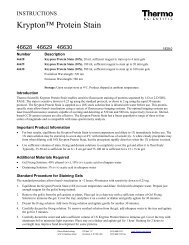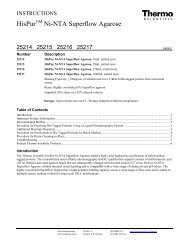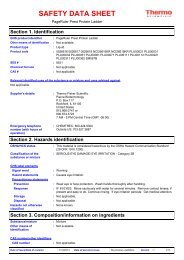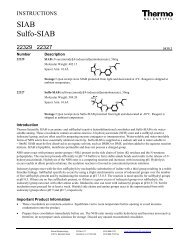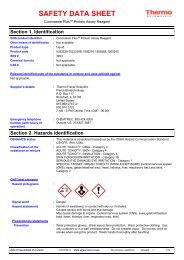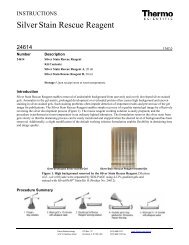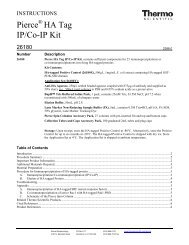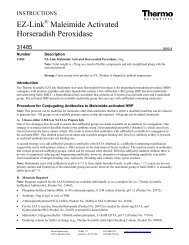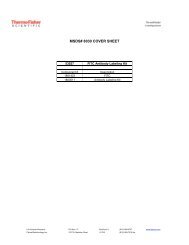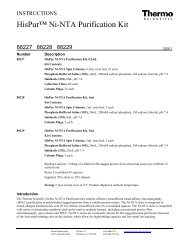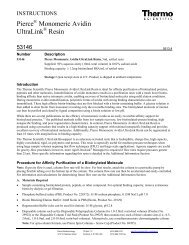Mouse IL-4 ELISA Kit - Pierce
Mouse IL-4 ELISA Kit - Pierce
Mouse IL-4 ELISA Kit - Pierce
You also want an ePaper? Increase the reach of your titles
YUMPU automatically turns print PDFs into web optimized ePapers that Google loves.
INSTRUCTIONS<br />
<strong>Mouse</strong> <strong>IL</strong>-4 <strong>ELISA</strong> <strong>Kit</strong><br />
EM<strong>IL</strong>4 EM<strong>IL</strong>42 EM<strong>IL</strong>45<br />
Number Description<br />
EM<strong>IL</strong>4<br />
<strong>Mouse</strong> Interleukin-4 (<strong>IL</strong>-4) <strong>ELISA</strong> <strong>Kit</strong>, sufficient reagents for 96 determinations<br />
EM<strong>IL</strong>42<br />
<strong>Mouse</strong> Interleukin-4 (<strong>IL</strong>-4) <strong>ELISA</strong> <strong>Kit</strong>, sufficient reagents for 2 × 96 determinations<br />
EM<strong>IL</strong>45<br />
<strong>Mouse</strong> Interleukin-4 (<strong>IL</strong>-4) <strong>ELISA</strong> <strong>Kit</strong>, sufficient reagents for 5 × 96 determinations<br />
1345.4<br />
<strong>Kit</strong> Contents EM<strong>IL</strong>4 EM<strong>IL</strong>42 EM<strong>IL</strong>45<br />
Anti-<strong>Mouse</strong> <strong>IL</strong>-4 Pre-coated 96-well Strip Plate 1 each 2 each 5 each<br />
Lyophilized Recombinant <strong>Mouse</strong> <strong>IL</strong>-4 Standard 2 vials 4 vials 5 vials<br />
Standard Diluent, contains 0.1% sodium azide 12mL 2 × 12mL 55mL<br />
Plate Reagent, contains 0.1% sodium azide 8mL 2 × 8mL 35mL<br />
30X Wash Buffer 50mL 2 × 50mL 200mL<br />
Prediluted Conjugate Reagent 12mL 2 × 12mL 55mL<br />
TMB Substrate 13mL 2 × 13mL 5 × 13mL<br />
Stop Solution, contains 0.16M sulfuric acid 13mL 2 × 13mL 55mL<br />
Adhesive plate sealers 6 each 12 each 30 each<br />
For research use only. Not for use in diagnostic procedures.<br />
Storage: For maximum stability, store in a non-defrosting -20ºC freezer and refer to the expiration<br />
date for frozen storage on the label. Alternatively, store at 2-8ºC and refer to the expiration date for<br />
refrigerated storage. Once thawed, store at 4ºC until the expiration date for refrigerated storage. <strong>Kit</strong> is<br />
shipped on dry ice.<br />
Table of Contents<br />
Introduction ................................................................................................................................................................................. 1<br />
Procedure Summary ..................................................................................................................................................................... 2<br />
Additional Materials Required ..................................................................................................................................................... 2<br />
Precautions ................................................................................................................................................................................... 2<br />
Sample Preparation ...................................................................................................................................................................... 3<br />
Reagent Preparation ..................................................................................................................................................................... 3<br />
Assay Procedure .......................................................................................................................................................................... 4<br />
Performance Characteristics ........................................................................................................................................................ 6<br />
Cited Reference ........................................................................................................................................................................... 6<br />
Introduction<br />
The Thermo Scientific <strong>Mouse</strong> Interleukin-4 (<strong>IL</strong>-4) <strong>ELISA</strong> is an in vitro enzyme-linked immunosorbent assay for<br />
quantification of mouse <strong>IL</strong>-4 in serum and culture supernatants.<br />
<strong>Pierce</strong> Biotechnology PO Box 117 (815) 968-0747 www.thermoscientific.com/pierce<br />
3747 N. Meridian Road Rockford, lL 61105 USA (815) 968-7316 fax
Procedure Summary<br />
1. Add 50µL of Plate<br />
Reagent to each well.<br />
2. Add 50µL of Standards or<br />
samples to each well in<br />
duplicate.<br />
3. Cover plate and incubate<br />
at 37°C for 2 hours in<br />
humidified incubator.<br />
4. Wash plate FIVE times.<br />
5. Add 100µl of Prediluted<br />
Conjugate Reagent to each<br />
well.<br />
6. Cover plate and incubate<br />
at 37°C for 1 hour in<br />
humidified incubator.<br />
7. Wash plate FIVE times. 8. Add 100µL Premixed<br />
TMB Substrate Solution to<br />
each well.<br />
9. Develop plate in the dark<br />
at room temperature (20-<br />
25°C) for 30 minutes.<br />
10. Stop reaction by adding<br />
100µL of Stop Solution to<br />
each well.<br />
11. Measure absorbance.<br />
Subtract 550nm values from<br />
450nm values.<br />
12. Calculate results using<br />
graph paper or curve-fitting<br />
statistical software.<br />
Additional Materials Required<br />
• Precision pipettors with disposable plastic tips to deliver 5-l000µL and plastic pipettes to deliver 5-15 mL<br />
• A glass or plastic 2L container to prepare Wash Buffer<br />
• A squirt wash bottle or an automated 96-well plate washer<br />
• 1.5mL polypropylene or polyethylene tubes to prepare standards − do not use polystyrene, polycarbonate or glass tubes<br />
• Disposable reagent reservoirs<br />
• A standard <strong>ELISA</strong> reader for measuring absorbance at 450nm and 550nm. If a 550nm filter is not available, the<br />
absorbance can be measured at 450nm only. Refer to the instruction manual supplied with the instrument being used.<br />
• Graph paper or a computerized curve-fitting statistical software package<br />
Precautions<br />
• All samples and reagents must be equilibrated to room temperature (20-25°C) before use in the assay.<br />
• Review these instructions carefully and verify all components against the <strong>Kit</strong> Contents list (page 1) before beginning.<br />
• Do not use a water bath to thaw samples. Thaw samples at room temperature.<br />
• Use a humidified 37°C incubator for sample and conjugate incubations.<br />
• When preparing standard curve and sample dilution in culture medium, use the same medium used to culture the cells.<br />
For example, if RPMI with 10% fetal calf serum (FCS) was used to culture cells, then use RPMI with 10% FCS to dilute<br />
the standard and samples. Do NOT use RPMI without serum supplement.<br />
• If using a multichannel pipettor, always use a new disposable reagent reservoir.<br />
• To avoid cross-contamination, use new disposable pipette tips for each transfer and a new adhesive plate cover for each<br />
incubation step.<br />
• Once reagents have been added to the plate, take care NOT to let plate DRY at any time during the assay.<br />
• Vigorous plate washing is essential.<br />
• Avoid exposing reagents to excessive heat or light during storage and incubation.<br />
<strong>Pierce</strong> Biotechnology PO Box 117 (815) 968-0747 www.thermoscientific.com/pierce<br />
3747 N. Meridian Road Rockford, lL 61105 USA (815) 968-7316 fax<br />
2
• Discard unused <strong>ELISA</strong> components after assay completion. Do not mix reagents from different kit lots.<br />
• Do not use glass pipettes to measure TMB Substrate Solution. Take care not to contaminate the Solution. If it is blue<br />
before use, DO NOT USE IT.<br />
• Individual components may contain antibiotics and preservatives. Wear gloves while performing the assay to avoid<br />
contact with samples and reagents. Please follow proper disposal procedures.<br />
• Some kit components contain sodium azide. Please dispose of reagents according to local regulations.<br />
Additional Precautions for the 2-plate and 5-plate <strong>Kit</strong>s<br />
• Dispense only the reagent volumes required for the number of plates being used. Do not combine leftover reagents with<br />
those reserved for additional plates.<br />
• Use only one bottle of the TMB Substrate Solution per 96-well plate. Do not combine leftover substrate with that<br />
reserved for other plates.<br />
• Equilibrate to room temperature only the reagent volumes required for the number of plates being used.<br />
• For the 5-plate kit, use only one vial of Standard per 96-well plate. The 2-plate kit is supplied with four vials of Standard.<br />
Therefore, four partial-plate assays may be performed.<br />
Sample Preparation<br />
Sample Handling<br />
• Serum and culture supernatants may be tested in this <strong>ELISA</strong>. Use 50 µl per well of serum or culture supernatant.<br />
• Store samples to be assayed within 24 hours at 2-8°C. For long-term storage, aliquot and freeze samples at -70°C.<br />
• Avoid repeated freeze-thaw cycles when storing samples.<br />
• Test samples and standards must be assayed in duplicate each time the <strong>ELISA</strong> is performed.<br />
• Gradually equilibrate samples to room temperature before beginning assay. Do not use a heated water bath to thaw or<br />
warm samples.<br />
• Mix samples by gently inverting tubes.<br />
• If samples are clotted, grossly hemolyzed, lipemic or microbially contaminated, or if there is any question about the<br />
integrity of a sample, make a note on the template and interpret results with caution.<br />
Sample Dilution<br />
• If the <strong>IL</strong>-4 concentration possibly exceeds the highest point of the standard curve (i.e., 375pg/mL), prepare one or more<br />
five-fold dilutions of the sample. When testing culture supernatants, prepare the dilutions using the culture medium.<br />
When testing serum, prepare the serial dilution using the Standard Diluent provided. For example, prepare a five-fold<br />
dilution by adding 100µL of sample to 400µL of appropriate diluent. Mix thoroughly between dilutions before assaying.<br />
Reagent Preparation<br />
For procedural differences when using partial plates, look for (PP) throughout this instruction booklet.<br />
Wash Buffer<br />
1. Label a clean glass or plastic 2L container “Wash Buffer.” The 30X Wash Buffer may have a cloudy appearance.<br />
2. If using a 5-plate kit, add 30mL Wash Buffer to 870mL of water for each plate being used, otherwise, add the entire<br />
contents of the 30X Wash Buffer bottle and dilute to a final volume of 1.5L with ultrapure water. Mix thoroughly. Wash<br />
Buffer must be equilibrated to room temperature before use in the assay.<br />
(PP) When using partial plates, store the reconstituted Wash Buffer at 2-8°C.<br />
Note: Wash buffer must be at room temperature before use in the assay. Do not use Wash Buffer if it becomes visibly<br />
contaminated during storage.<br />
<strong>Pierce</strong> Biotechnology PO Box 117 (815) 968-0747 www.thermoscientific.com/pierce<br />
3747 N. Meridian Road Rockford, lL 61105 USA (815) 968-7316 fax<br />
3
Standards<br />
• (PP) Reconstitute and use one vial of the lyophilized Standard per partial plate.<br />
• Prepare Standards just before use and use within one hour of reconstitution. Do not store reconstituted standards.<br />
When testing culture supernatant samples, reconstitute standard in sample culture medium. Reconstitution volume is<br />
stated on the standard vial label. The standard will dissolve in approximately 1 minute. Mix by gently inverting vial. Use<br />
the sample culture medium to prepare Standard Curve dilutions. The concentration will be 375pg/mL, which is the<br />
highest point of the standard curve.<br />
When testing serum samples, reconstitute standard with ultrapure water. Reconstitution volume is stated on the standard<br />
vial label. The standard will dissolve in approximately 1 minute. Mix by gently inverting vial. The concentration will be<br />
375pg/mL, which is the highest point of the standard curve. Use the Standard Diluent provided to prepare standard curve<br />
serial dilutions.<br />
When testing both serum and cell culture supernatant samples on the same plate, validate the media to establish if<br />
the same standard curve may be used for both sample types. Prepare a standard curve (including a zero/blank) using<br />
culture medium to reconstitute and dilute the standard. Perform this curve in parallel with a standard curve reconstituted<br />
in ultrapure water and diluted in the Standard Diluent provided. If the OD values of the two curves are within 10% of the<br />
mean for both curves, then the assay may be performed using either curve.<br />
1. Label three tubes, one for each of the remaining standard curve points: 375pg/mL, 75pg/mL, 15pg/mL and 0pg/mL, then<br />
prepare 1:5 serial dilutions for the standard curve as follows:<br />
2. Pipette 400µL of appropriate diluent into each tube.<br />
3. Pipette 100µL of the reconstituted standard into the first tube (i.e., 75pg/mL) and mix.<br />
4. Pipette 100µL of this dilution into the second tube (i.e., 15pg/mL) and mix.<br />
Serial dilutions using 100µL<br />
Assay Procedure<br />
A. Sample Incubation<br />
• (PP) Determine number of strips required. Leave these strips in the plate frame. Tightly seal unused strips in the<br />
provided foil pouch with desiccant and store at 2-8°C. After completing assay, retain plate frame for second partial plate.<br />
When using the second partial plate, place strips securely in the plate frame.<br />
• Use the Data Template provided to record the locations of the zero standard (blank or negative control), <strong>IL</strong>-4 standards<br />
and test samples. Perform three standard points and one blank in duplicate with each series of unknown samples.<br />
• If using a multichannel pipettor, use a new reagent reservoir to add the Plate Reagent. Remove from the vial only the<br />
amount required for the number of strips being used.<br />
1. Add 50µL of Plate Reagent to all wells being used.<br />
2. Add 50µL of reconstituted standards or test samples in duplicate to each well.<br />
Note: If the mouse <strong>IL</strong>-4 concentration in any test sample possibly exceeds the highest point on the standard curve,<br />
375pg/mL, see Sample Preparation − Sample Dilution Section.<br />
3. Carefully cover plate with an adhesive plate cover. Ensure all edges and strips are tightly sealed by running your thumb<br />
over edges and down each strip. Incubate for two (2) hours at 37°C in a humidified incubator.<br />
4. Carefully remove adhesive plate cover. Wash plate FIVE times with Wash Buffer as described in the Plate Washing<br />
Section (section B).<br />
<strong>Pierce</strong> Biotechnology PO Box 117 (815) 968-0747 www.thermoscientific.com/pierce<br />
3747 N. Meridian Road Rockford, lL 61105 USA (815) 968-7316 fax<br />
4
B. Plate Washing<br />
1. Gently squeeze the long sides of plate frame before washing to ensure all strips securely remain in the frame.<br />
2. Empty plate contents. Use a squirt bottle to vigorously fill each well completely with Wash Buffer, then empty plate<br />
contents. Repeat procedure four additional times for a total of FIVE washes. Blot plate onto paper towels or other<br />
absorbent material.<br />
Note: For automated washing, aspirate all wells and wash FIVE times with Wash Buffer, over-filling wells with Wash<br />
Buffer. Blot plate onto paper towels or other absorbent material.<br />
C. Conjugate Incubation<br />
1. Add 100µL of Prediluted Conjugate Reagent to each well. If using a multichannel pipettor, use a new reagent reservoir<br />
when adding the Conjugate Reagent.<br />
2. Carefully attach a new adhesive plate cover. Make sure all edges and strips are tightly sealed. Incubate plate for<br />
one (1) hour at 37°C in a humidified incubator.<br />
3. Carefully remove adhesive plate cover and wash FIVE times as described in the Plate Washing Section.<br />
D. Substrate Incubation and Stop Step<br />
• Use new disposable reagent reservoirs when adding the TMB Substrate Solution and Stop Solution.<br />
• (PP) Do not combine leftover substrate with that reserved for the second partial plate. Take care not to contaminate<br />
remaining TMB Substrate Solution<br />
1. Dispense from bottle ONLY amount required, 100µL per well, for the number of wells being used. Do not use a glass<br />
pipette to measure the TMB Substrate Solution.<br />
2. Pipette 100µL of TMB Substrate Solution into each well.<br />
3. Allow color reaction to develop at room temperature in the dark for 30 minutes. Do not cover plate with aluminum foil<br />
or a plate sealer. The substrate reaction yields a blue solution that turns yellow when Stop Solution is added.<br />
4. After 30 minutes, stop the reaction by adding 100µL of Stop Solution to each well.<br />
E. Absorbance Measurement<br />
Note: Evaluate the plate within 30 minutes of stopping the reaction.<br />
Measure absorbance on an <strong>ELISA</strong> plate reader set at 450nm and 550nm. Subtract 550nm values from 450nm values to<br />
correct for optical imperfections in the microplate. If absorbance at 550nm is unavailable, measure the absorbance at 450nm<br />
only. When the 550nm measurement is omitted, absorbance values will be higher.<br />
F. Results Calculations<br />
• Generate the standard curve by plotting the average absorbance obtained<br />
for each Standard concentration on the vertical (Y) axis vs. the<br />
corresponding <strong>IL</strong>-4 concentration (pg/ml) on the horizontal (X) axis.<br />
Standard Curve Example<br />
• Calculate results using graph paper or curve-fitting statistical software.<br />
Determine the <strong>IL</strong>-4 amount in each sample by interpolating from the<br />
absorbance value (Y-axis) to <strong>IL</strong>-4 concentration (X-axis) using the<br />
standard curve.<br />
• If the test sample was diluted, multiply the interpolated value obtained<br />
from the standard curve by the dilution factor to calculate pg/ml of <strong>IL</strong>-<br />
4 in the sample.<br />
A450 minus A550<br />
• Absorbance values obtained for duplicates should be within 10% of the<br />
mean value. Carefully consider duplicate values that differ from the mean by greater<br />
than 10%.<br />
<strong>Mouse</strong> <strong>IL</strong>-4 (pg/mL)<br />
<strong>Pierce</strong> Biotechnology PO Box 117 (815) 968-0747 www.thermoscientific.com/pierce<br />
3747 N. Meridian Road Rockford, lL 61105 USA (815) 968-7316 fax<br />
5
Performance Characteristics<br />
Sensitivity: < 5pg/mL<br />
The sensitivity or Lower Limit of Detection (LLD) 1 was determined by assaying replicates of zero and the standard curve.<br />
The mean signal of zero + 2 standard deviations read in dose from the standard curve is the LLD. This value is the smallest<br />
dose that is not zero with 95% confidence.<br />
Assay Range: 15-375pg/mL<br />
Suggested standard curve points are 0, 15, 75 and 375pg/mL.<br />
Reproducibility:<br />
Intra-assay CV: < 10%<br />
Inter-assay CV: < 10%<br />
Specificity: Natural and recombinant mouse <strong>IL</strong>-4. This <strong>ELISA</strong> does not cross-react with mouse <strong>IL</strong>-2, <strong>IL</strong>-3, <strong>IL</strong>-5, <strong>IL</strong>-6, <strong>IL</strong>-7,<br />
IFNγ, GM-CSF, TNFα; rat <strong>IL</strong>-4; rabbit <strong>IL</strong>-4; or human <strong>IL</strong>-4.<br />
Calibration: The standard in this <strong>ELISA</strong> assay is calibrated to NCI BRB reference standard 91/656.<br />
One (1) pg = one (1) NCI BRB pg.<br />
Cited Reference<br />
1. In Immunoassay: A Practical Guide, Chan and Perlstein, Eds., 1987, Academic Press: New York, p71.<br />
This product (“Product”) is warranted to operate or perform substantially in conformance with published Product specifications in effect at the time of sale,<br />
as set forth in the Product documentation, specifications and/or accompanying package inserts (“Documentation”) and to be free from defects in material and<br />
workmanship. Unless otherwise expressly authorized in writing, Products are supplied for research use only. No claim of suitability for use in applications<br />
regulated by FDA is made. The warranty provided herein is valid only when used by properly trained individuals. Unless otherwise stated in the<br />
Documentation, this warranty is limited to one year from date of shipment when the Product is subjected to normal, proper and intended usage. This<br />
warranty does not extend to anyone other than the original purchaser of the Product (“Buyer”).<br />
No other warranties, express or implied, are granted, including without limitation, implied warranties of merchantability, fitness for any particular<br />
purpose, or non infringement. Buyer’s exclusive remedy for non-conforming Products during the warranty period is limited to replacement of or<br />
refund for the non-conforming Product(s).<br />
There is no obligation to replace Products as the result of (i) accident, disaster or event of force majeure, (ii) misuse, fault or negligence of or by Buyer, (iii)<br />
use of the Products in a manner for which they were not designed, or (iv) improper storage and handling of the Products.<br />
Current product instructions are available at www.thermoscientific.com/pierce. For a faxed copy, call 800-874-3723 or contact your local distributor.<br />
© 2012 Thermo Fisher Scientific Inc. All rights reserved. Unless otherwise indicated, all trademarks are property of Thermo Fisher Scientific Inc. and its<br />
subsidiaries. Printed in the USA.<br />
<strong>Pierce</strong> Biotechnology PO Box 117 (815) 968-0747 www.thermoscientific.com/pierce<br />
3747 N. Meridian Road Rockford, lL 61105 USA (815) 968-7316 fax<br />
6
Data Templates<br />
<strong>Pierce</strong> Biotechnology PO Box 117 (815) 968-0747 www.thermoscientific.com/pierce<br />
3747 N. Meridian Road Rockford, lL 61105 USA (815) 968-7316 fax<br />
7



